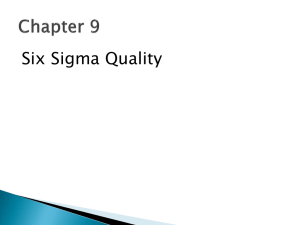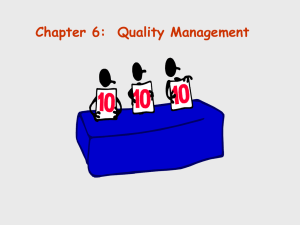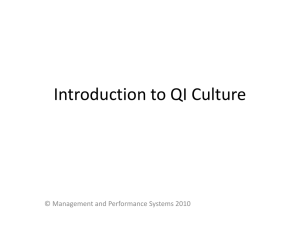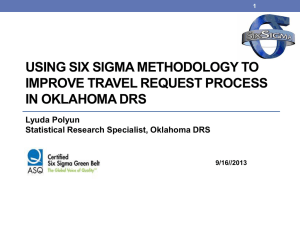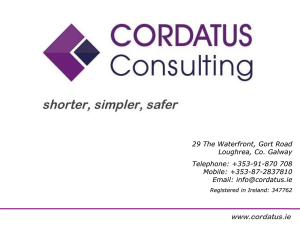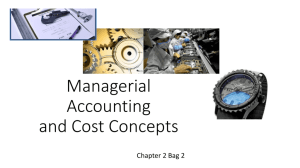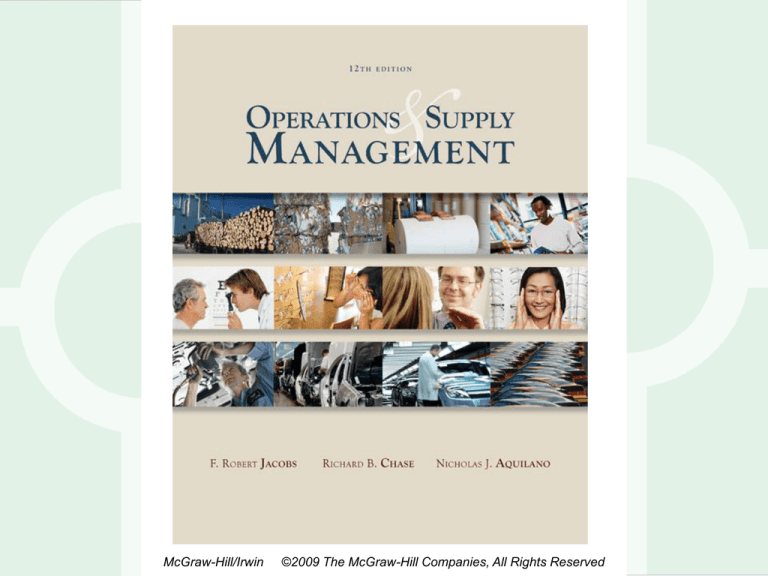
1
•
McGraw-Hill/Irwin
©2009 The McGraw-Hill Companies, All Rights Reserved
1-1
2
Chapter 9
Quality Management
1-2
3
OBJECTIVES
•
•
•
•
•
•
Total Quality Management Defined
Quality Specifications and Costs
Six Sigma Quality and Tools
External Benchmarking
ISO 9000
Service Quality Measurement
1-3
4
Total Quality Management (TQM)
• Total quality management is
defined as managing the
entire organization so that it
excels on all dimensions of
products and services that
are important to the
customer
1-4
5
Quality Specifications
• Design quality: Inherent value of
the product in the marketplace
– Dimensions include: Performance,
Features, Reliability/Durability,
Serviceability, Aesthetics, and
Perceived Quality.
• Conformance quality: Degree to
which the product or service
design specifications are met
1-5
6
Costs of Quality
Appraisal Costs
External Failure
Costs
Costs of
Quality
Prevention Costs
Internal Failure
Costs
1-6
7
Biaya Kualitas
Biaya penilaian
Inspeksi dan pengujian incoming material
Inspeksi dan pengujian produk
Bahan yang terpakai
Pemeliharaan akurasi peralatan tes
1-7
8
Biaya Kualitas
Biaya Pencegahan
Perencanaan dan rekayasa mutu
Evaluasi produk baru
Desain produk/proses
Pengendalian proses
Kegagalan di usia dini
Pelatihan
Pengadaan dan analisa data kualitas
1-8
9
Biaya Kualitas
Biaya kegagalan internal
Scrap
Pengerjaan ulang
Pengujian ulang
Analisa kegagalan
Waktu menganggur
Kerugian penurunan output
Penurunan grade
1-9
10
Biaya Kualitas
Biaya kegagalan external
Penangana komplain
Produk/material yang dikembalikan
Biaya jaminan
Biaya pertanggungan
Biaya tak langsung
1-10
11
Six Sigma Quality
• A philosophy and set of methods
companies use to eliminate
defects in their products and
processes
• Seeks to reduce variation in the
processes that lead to product
defects
1-11
12
Six Sigma Quality (Continued)
• Six Sigma allows managers to readily
describe process performance using a
common metric: Defects Per Million
Opportunities (DPMO)
DPMO
Number of defects
x 1,000,000
Number of
opportunit ies
for error per x No. of units
unit
1-12
13
Six Sigma Quality (Continued)
Example of Defects Per Million
Opportunities (DPMO) calculation.
Suppose we observe 200 letters
delivered incorrectly to the wrong
addresses in a small city during a
single day when a total of 200,000
letters were delivered. What is the
DPMO in this situation?
DPMO
200
1 x 200,000
So, for every one
million letters
delivered this
city’s postal
managers can
expect to have
1,000 letters
incorrectly sent
to the wrong
address.
x 1,000,000 1, 000
Cost of Quality: What might that DPMO mean in terms
of over-time employment to correct the errors?
1-13
14
Six Sigma Quality: DMAIC Cycle
• Define, Measure, Analyze,
Improve, and Control (DMAIC)
• Developed by General Electric
as a means of focusing effort on
quality using a methodological
approach
• Overall focus of the
methodology is to understand
and achieve what the customer
wants
• A 6-sigma program seeks to
reduce the variation in the
processes that lead to these
defects
• DMAIC consists of five steps….
1-14
15
Six Sigma Quality: DMAIC Cycle (Continued)
1. Define (D)
Customers and their priorities
2. Measure (M)
Process and its performance
3. Analyze (A)
Causes of defects
4. Improve (I)
Remove causes of defects
5. Control (C)
Maintain quality
1-15
16
Example to illustrate the process…
• We are the maker of this cereal.
Consumer reports has just published
an article that shows that we
frequently have less than 16 ounces
of cereal in a box.
• What should we do?
1-16
17
Step 1 - Define
• What is the critical-to-quality
characteristic?
• The CTQ (critical-to-quality)
characteristic in this case is the
weight of the cereal in the box.
1-17
18
Step 2 - Measure
• How would we measure to
evaluate the extent of the
problem?
• What are acceptable limits on
this measure?
1-18
19
2 – Measure (continued)
• Let’s assume that the
government says that we must
be within ± 5 percent of the
weight advertised on the box.
• Upper Tolerance Limit = 16 +
.05(16) = 16.8 ounces
• Lower Tolerance Limit = 16 –
.05(16) = 15.2 ounces
1-19
20
2 - Measure (continued)
• We go out and buy 1,000
boxes of cereal and find that
they weight an average of
15.875 ounces with a standard
deviation of .529 ounces.
• What percentage of boxes are
outside the tolerance limits?
1-20
21
Lower Tolerance
= 15.2
Process
Mean = 15.875
Std. Dev. = .529
Upper Tolerance
= 16.8
What percentage of boxes are defective (i.e. less than 15.2 oz)?
Z = (x – Mean)/Std. Dev. = (15.2 – 15.875)/.529 = -1.276
NORMSDIST(Z) = NORMSDIST(-1.276) = .100978
Approximately, 10 percent of the boxes have less than 15.2
Ounces of cereal in them!
1-21
22
Step 3 - Analyze - How can we improve the
capability of our cereal box filling process?
– Decrease Variation
– Center Process
– Increase
Specifications
1-22
23
Step 4 – Improve – How good is good enough?
Motorola’s “Six Sigma”
– 6s minimum from process
center to nearest spec
12s
6s
3
2
1
0
1
2
3
1-23
24
Motorola’s “Six Sigma”
• Implies 2 ppB “bad” with no
process shift
• With 1.5s shift in either direction
from center (process will move),
implies 3.4 ppm “bad”.
12s
3
2
1
0
1
2
3
1-24
25
Step 5 – Control
• Statistical Process Control
(SPC)
– Use data from the actual
process
– Estimate distributions
– Look at capability - is good
quality possible
– Statistically monitor the
process over time
1-25
26
Analytical Tools for Six Sigma and Continuous
Improvement: Flow Chart
Material
Received
from
Supplier
No,
Continue…
Inspect
Material for
Defects
Defects
found?
Yes
Can be used to
find quality
problems
Return to
Supplier
for Credit
1-26
27
Diameter
Analytical Tools for Six Sigma and Continuous Improvement: Run Chart
Can be used to identify
when equipment or
processes are not
behaving according to
specifications
0.58
0.56
0.54
0.52
0.5
0.48
0.46
0.44
1
2
3
4
5
6
7
8
Time (Hours)
9
10 11 12
1-27
28
Analytical Tools for Six Sigma and Continuous Improvement: Pareto
Analysis
80%
Frequency
Can be used
to find when
80% of the
problems
may be
attributed to
20% of the
causes
Design
Assy.
Instruct.
Purch.
Training
1-28
29
Analytical Tools for Six Sigma and Continuous
Improvement: Checksheet
Monday
Can be used to keep track of
defects or used to make sure
people collect data in a
correct manner
Billing Errors
Wrong Account
Wrong Amount
A/R Errors
Wrong Account
Wrong Amount
1-29
30
Number of Lots
Analytical Tools for Six Sigma and Continuous Improvement:
Histogram
Can be used to identify the frequency of quality
defect occurrence and display quality
performance
0
1
2
Data Ranges
3
4 Defects
in lot
1-30
31
Analytical Tools for Six Sigma and Continuous Improvement:
Cause & Effect Diagram
Possible causes:
Machine
Man
The results
or effect
Effect
Environment
Method
Material
Can be used to systematically track backwards to
find a possible cause of a quality problem (or
effect)
1-31
32
Analytical Tools for Six Sigma and Continuous Improvement:
Control Charts
Can be used to monitor ongoing production process
quality and quality conformance to stated standards of
quality
1020
UCL
1010
1000
990
LCL
980
970
0
1
2
3
4
5
6
7
8
9
10 11 12 13 14 15
1-32
33
Other Six Sigma Tools
• Failure Mode and Effect Analysis
(DMEA) is a structured approach to
identify, estimate, prioritize, and
evaluate risk of possible failures at
each stage in the process
• Design of Experiments (DOE) a
statistical test to determine causeand-effect relationships between
process variables and output
1-33
34
Six Sigma Roles and Responsibilities
1. Executive leaders must
champion the process of
improvement
2. Corporation-wide training
in Six Sigma concepts and
tools
3. Setting stretch objectives
for improvement
4. Continuous reinforcement
and rewards
1-34
35
The Shingo System: Fail-Safe Design
• Shingo’s argument:
–
–
–
SQC methods do not prevent defects
Defects arise when people make
errors
Defects can be prevented by
providing workers with feedback on
errors
• Poka-Yoke includes:
– Checklists
– Special tooling that prevents
workers from making errors
1-35
36
ISO 9000 and ISO 14000
• Series of standards agreed upon by
the International Organization for
Standardization (ISO)
• Adopted in 1987
• More than 160 countries
• A prerequisite for global competition?
• ISO 9000 an international reference for
quality, ISO 14000 is primarily
concerned with environmental
management
1-36
37
Three Forms of ISO Certification
1. First party: A firm audits itself
against ISO 9000 standards
2. Second party: A customer audits
its supplier
3. Third party: A "qualified" national
or international standards or
certifying agency serves as
auditor
1-37
38
External Benchmarking Steps
1. Identify those processes
needing improvement
2. Identify a firm that is the world
leader in performing the
process
3. Contact the managers of that
company and make a personal
visit to interview managers and
workers
4. Analyze data
1-38
39
End of Chapter 9
1-39


